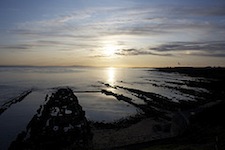JOHN FEENEY

John Feeney
Biography
From the CD Booklet " When It's Moonlight In Mayo "
When the SS Samaria docked in New York from Cobh on 11 June 1928, the ship's passengers included a twenty-four year old immigrant named John Feeney who had journeyed from the town of Swinford in Co Mayo. Feeney had an unusual reason for making his journey: he had come to the United States to pursue his personal dream, to have his tenor voice trained and ultimately earn his living as a professional singer.
Tenors played a central role during that era in many areas of music-making, ranging from grand opera to vaudeville. The 'Irish Tenor" genre had been consolodated in the United States in the course of the previous half-century by performers such as William Scanlan, Andrew Mack and Chauncey Olcott. Contemporary stars lile Fiske O'Hara, Morton Downey and others were celebrated as actor-tenors in the musical plays that were then in vogue among theatre audiences and also as singers on record and on radio.
John McCormack eclipsed all other tenors in the field and became a singing legend, setting new standards of achievement for tenors. McCormack was at the peak of his success in the 1920s when he was acknowledged as one of the worlld's most popular tenors, a position that placed him among the highest paid entertainers at that time.
John McCormack's successes on the concert platform and on record were a matter of great pride to Irish people at home and in the United States in the early part of the 20th century. The resulting popularity of the Irish tenor style of singing, in general, reflected the aspirations of the increasingly prosperous and middle-class Irish in the United States and the pride and optimism in the new Irish Republic felt by Irish people everywhere.
Within five years of arriving in New York, John Feeney had made impressive progress towards his goal, as can be seen in a report in the August 1933 edition of New York's Gaelic American newspaper. The paper's music critic set out to list his favourite Irish tenors. Not surprisingly, John McCormack headed the selection but it is noteworthy that the writer could list seventeen other Irish tenors then performing in New York. The writer concluded by drawing special attention to one tenor in particular, the newly-arrived John Feeney, who had already attracted favourable critical attention.
.....The handsome Mayo lad is a plugger, sixty minutes or more a day, seven days a week is nothing for this busy young man to use for voice culture and training. He'll go a long way, mark my words.
John Feeney did indeed go a long way. After some initial succeses as an Irish tenor on 78 rpm records, John embarked on a career in commercial radio and became a well-known singing personality on the airwaves. As his reputation as a radio singer grew, John began to perform in America's foremost concert halls and recital venues. His position as a leading Irish-American tenor was confirmed by film appearances and in later years, by television work.
Releases
ACCOUNT
SHOPPING CART
You have no items in your order.
MAILING LIST
TOP SELLERS
- Órach
The Tannahill Weavers
CD: £12.15 - In Praise of Home
Rura
CD: £11.80 - Beyond
Talisk
CD: £10.29 - St. Kilda Wedding
Ossian
Download: £7.00 - Osgarra
Beinn Lee
CD: £11.80 - 100 Scottish Greats
Various Artists
4xCD: £9.40 - Sleeper
Kan
CD: £12.60 - Songs Of The Jacobites -Vol 2
Kenneth McKellar - Evo
Skerryvore
CD: £10.00 - Cavalier
Eddi Reader
CD: £10.00
YOUTUBE
We have a YouTube channel where you can watch some of the celtic music related videos we've found.www.youtube.com/allcelticmusic
Threads of Sound
The downloads on this site are provided by Threads of Sound. They also distribute music to iTunes, eMusic, Spotify and many others. If you want to sell your music on all celtic then you register it via Threads of Sound.www.threadsofsound.net

MASTHEAD
Our current header image was taken by Nick Bramhall and you can find the original here.Privacy Policy | Terms & Conditions | Contact Us
© Threads of Sound Music Services Limited. T/A All Celtic Music - Registered in Scotland no. 475134
